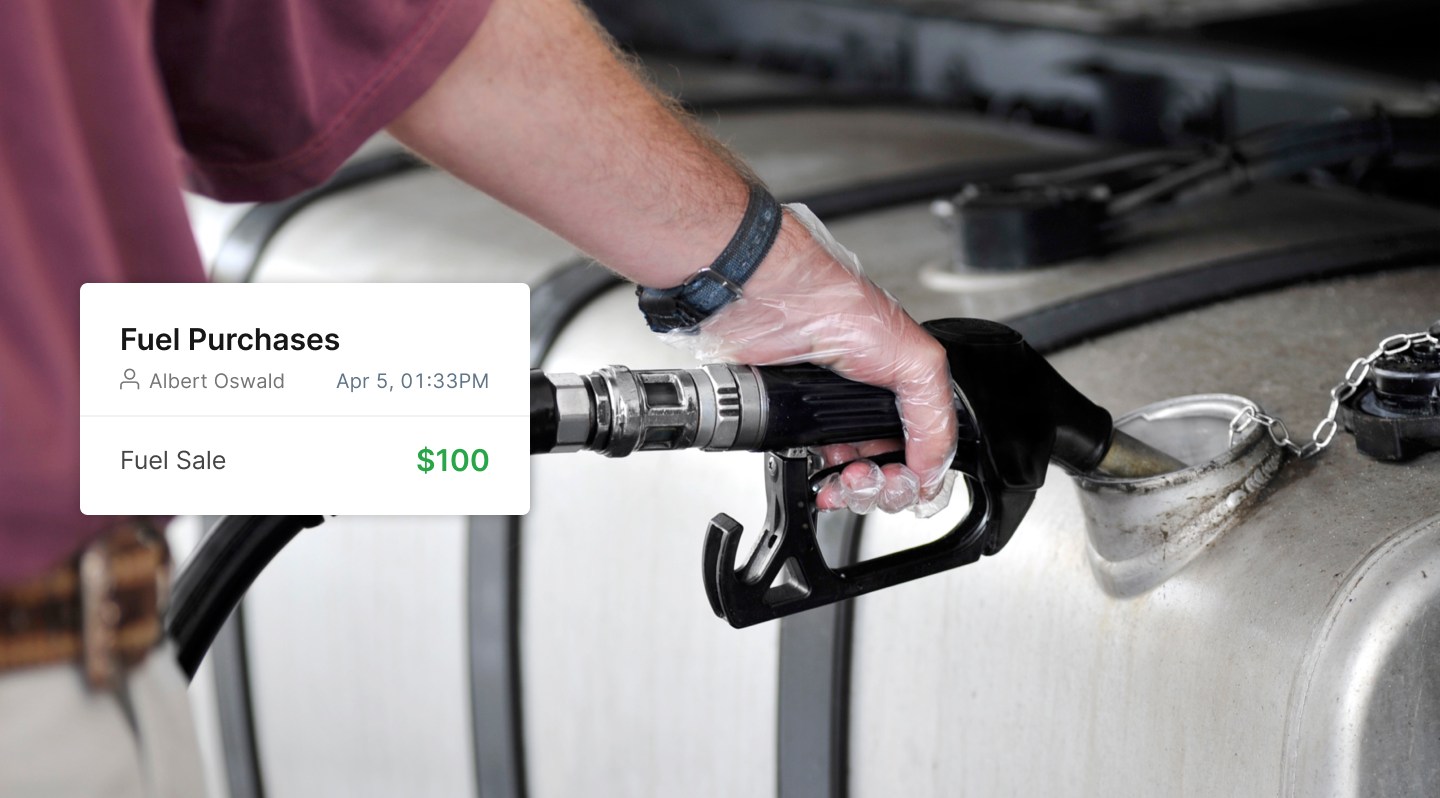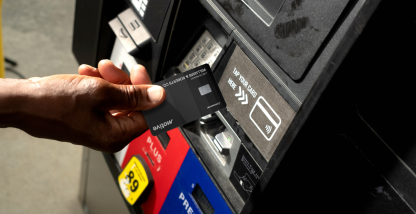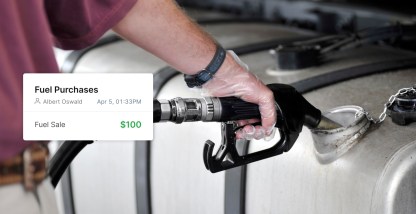Oil prices are surging again on the heels of an OPEC move to cut production. The rising prices are big news, especially for fleets with fuel as one of your major costs. Yet a fleet fuel management system can give you the data you need to more effectively monitor and manage fuel usage. And that’s not the only benefit. Read on to learn more about this technology, its advantages, and how to implement it in your fleet.
Save on fuel and maintenance with the Motive Card.
What makes up a fuel management system?
A fully integrated fuel management system combines fuel monitoring technology, data management tools, and spend controls in one platform. With fuel typically more than half the company’s total operating budget, fleet managers often rely on fuel monitoring software to cut this expense.
Fleet fuel monitoring
On-board sensors monitoring the fuel level in storage tanks and GPS tracking data provide real-time insights. With the integration of telematics data providing information on fuel usage, inventory levels, and other key metrics, the fuel monitoring system can also help to detect fuel theft and identify inefficient vehicles.
Data management
Collecting, analyzing, and using data related to fuel levels in storage tanks, vehicles, or equipment can optimize fuel usage and improve operational efficiency. Digital technology lets you avoid reliance on manual record keeping or waiting for drivers to hand in receipts or logs. Instead, with accurate and timely information about fuel consumption, fleet managers can make informed decisions and take action to improve fuel efficiency.
A fleet fuel management system can also integrate important data about vehicle location, maintenance records, driver behavior, and more. With this holistic view of all the factors impacting fuel consumption, it’s possible to not only realize cost savings but also improve efficiency and increase profitability while preventing theft and avoiding asset downtime. We’ll explore these benefits in more detail in the next section.
Fuel purchase management
Effective fuel purchase management helps fleets optimize fuel costs, streamline purchasing processes, and reduce fraud risk. With the software offering purchase tracking and analysis tools, operational efficiency improves and organizations can achieve significant cost savings.
Key features of a fuel purchase management solution include:
- Real-time fuel card purchase tracking enabling you to identify unauthorized or fraudulent purchases and take action to prevent misuse of fuel cards.
- Fuel card purchase analytics to help optimize fuel usage and reduce expenses. This could include identifying patterns in fuel usage, comparing fuel costs across different regions, or identifying opportunities to reduce fuel consumption.
- Fuel card controls such as spending limits, transaction restrictions, or location restrictions that help organizations manage fuel card usage.
Benefits of a fleet fuel management system
Fleet fuel management systems allow fleet managers to monitor and control fuel consumption to reduce and optimize fuel-related expenses. But cost reduction isn’t the only advantage of this technology as you’ll see in this section.
Cost reduction
Reducing idle time is key to cutting fuel consumption. An integrated fuel management solution can help you identify inefficient vehicles or drivers that subject vehicles to excess wear and tear. You’ll also be able to track how much time drivers spend idling at different stops to optimize routes and cut waiting times.
With fuel purchase management tools you can also reduce fuel theft and control driver spending with fuel cards. Fleet cards also provide access to discounted fuel and services and enable more accurate billing and payment with data analysis to prevent overpayments and identify billing errors.
Increase efficiency
Integrating fuel management with fleet telematics leads to more efficient dispatch and routing, which can lower fuel usage and avoid compliance issues. The data can also help fleet managers reduce costly downtime by identifying maintenance issues before they become major problems.
Analyzing fuel usage reports, you get an overview of fuel consumption which also enables you to identify top- and under-performing drivers. This can help you determine driver coaching opportunities to encourage more efficient driving.
Enable preventative maintenance
Integrating vehicle telematic data with fuel consumption information may help you detect engine issues or other maintenance concerns before they cause breakdowns. Analyzing vehicle fuel usage and driver behavior, you might also identify behaviors that contribute to vehicle wear and tear. For instance, you might educate drivers to better anticipate traffic flow to avoid hard braking.
Sustainability
Improving fuel efficiency is an important step in meeting fleet sustainability goals. Gaining access to all fuel consumption trends, you can use fuel monitoring to compare across the fleet or look at specific MPG or idle time for individual drivers or vehicles.
Motive’s fuel management system provides fuel monitoring benchmarked across our entire network of 700k+ vehicles. This gives your data essential context to help you improve your fuel management and fleet sustainability.
How to implement a fleet fuel management system
1. Planning
Before implementing a fleet fuel management technology, first take stock of your current processes:
- How is fuel managed and monitored now?
- What gaps are there in your system?
- Where could managers and drivers gain from enhanced fuel visibility?
These questions help identify areas of improvement, which can narrow down your choices when selecting the right solution to meet your needs. You’ll also want to set goals for fuel reduction and cost savings to be able to better gauge the actual return on investment of your new system.
2. Execution
Consider these factors when evaluating vendors to determine the best fleet fuel management for your business:
- Features. The software should include features such as real-time fuel monitoring, fuel inventory tracking, fuel consumption analysis, fuel card management, and automated reporting.
- Ease of use. The monitoring and control system needs to be easy to use if you want drivers and managers to adopt the technology. The user interface should be intuitive and user-friendly, with clear instructions and minimal training required.
- Integration. Selecting software that integrates with your fleet management systems or accounting software can streamline processes and add efficiency.
- Customization. You should be able to customize reports, dashboards, or alerts to meet the unique needs of your organization.
- Security. Robust security is necessary to protect sensitive fuel management data. Look for features such as role-based access controls, data encryption, or two-factor authentication.
- Cost. Look for an affordable system that provides value for the cost. It’s important to consider the total cost of ownership, including licensing fees, implementation costs, and ongoing support costs.
- Customer service. Check if the vendor has a support line that your managers and drivers can immediately access via SMS or phone.
3. Monitoring
Reliable fuel monitoring software provides visibility into your fleet’s fuel consumption as well as driving habits, vehicle conditions, and other factors leading to fuel waste. Take advantage of the findings and in-depth summaries to analyze data for trends and adjust your goals as needed.
Analyzing the data you might identify areas for further optimization and be able to make more cost-saving decisions. For example, you might rank the most and least fuel-efficient drivers. This can help you determine who needs further driver coaching. You might also reward more fuel-efficient drivers, which can help with retention.
Explore the Motive all-in-one fleet management solution
Improving fleet fuel efficiency saves operating budget and can free up money for other growth-driving aspects of your business. Invest more in recruiting drivers, driver training, acquiring new vehicles, or marketing to new customers.
Motive’s all-in-one fleet management system integrates fuel management with many more useful tools. Leverage our Vehicle Gateway to optimize routes with driver schedules, road conditions, delivery priorities, and other constraints factored into the planning. Install our dashboard cameras to identify fuel-wasting driving behaviors and improve road safety with alerts on the road and post-trip training offered through our Driver App.
Motive also offers a fleet fuel card enabling your fleet drivers to purchase discounted fuel at select gas stations. They’ll enjoy access to reduced prices at our maintenance shop partners as well. Managers can also establish customized controls on the fleet cards to prevent unauthorized consumption and restrict purchases to at-pump only.
Connect with a sales rep to learn more about Motive’s comprehensive fleet management system powered by artificial intelligence (AI). Or request a demo of a fleet fuel management system for your operations.










